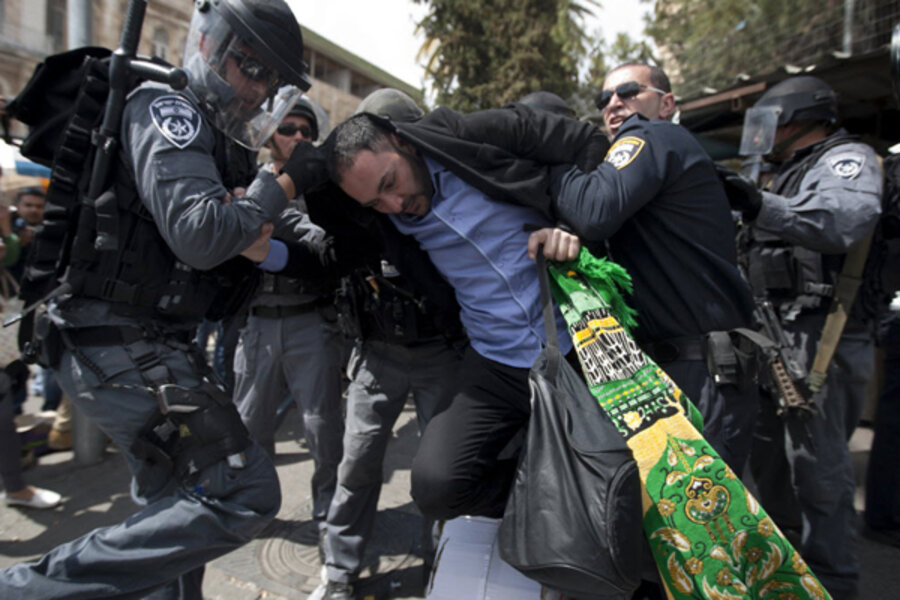Gaza man killed by soldiers as thousands protest Israel policy
| JERUSALEM
Israeli troops shot dead a Palestinian protester in Gaza on Friday as thousands in the Palestinian territories, Israel and neighboring countries participated in an annual protest against the Jewish state's land policies.
Security forces in riot gear deployed in high numbers along the frontiers of Israel and the Palestinian territories in anticipation of a repeat of last year's violence, in which at least 38 people died near the borders with Lebanon and Syria.
But for the most part, protests were small and organizers kept demonstrators from actually marching on the borders.
The "Land Day" rallies are an annual event marked by Israeli Arabs and Palestinians in the West Bank andGaza who protest what they say are discriminatory Israeli land policies.
Gaza health official Adham Abu Salmia said Israeli forces shot and killed Mahmoud Zaqout, 21, and critically wounded another man as they were approaching the Israel-Gaza border during a demonstration of a few thousand people organized by the territory's Hamas rulers.
The Israeli military said troops fired warning shots before shooting directly at Zaqout, in accordance with the army's rules of engagement.
The military said it responded to protesters with tear gas in addition to gunfire. Abu Salmia said an additional 37 protesters throughout Gaza were lightly injured, while the Israeli military put the number at about 29.
By midday, skirmishes had broken out between protesters and security forces in the Jerusalem area. Palestinians threw rocks and Israeli troops responded with tear gas, stun grenades and rubber pellets.
Dozens of Palestinians were treated for light wounds in hospitals throughout the West Bank and Jerusalem, including four with serious head wounds from rubber pellets and one hit in the head by a tear gas canister, said Mohammed Ayyad, a spokesman for the Red Crescent medical service in Ramallah.
In southern Lebanon Friday, thousands of Lebanese and Palestinians gathered outside the Crusader-built Beaufort castle 15 kilometers (9 miles) from Israel. Lebanese security forces kept them from moving any closer to the border.
Last year, demonstrators from Lebanon and Syria tried twice to break across the borders into Israel, setting off clashes with Israeli troops in which at least 38 people were killed.
Sobhiyeh Mizari, 70, said she always taught her 12 children "never to forget Palestine."
"We will liberate our land against the will of Israel and its backers," said Mizari, who said her husband was killed in Israeli shelling of Lebanon in 1978.
Among the protesters in Lebanon were rabbis from the ultra-Orthodox Jewish sect Neturei Karta, a radical anti-Israel group that believes Jews must live without a country of their own until the coming of the Messiah.
In Jordan, thousands of demonstrators gathered a few kilometers (miles) east of Jordan's border with the West Bank, chanting, "Death to Israel." Israel controls the West Bank side of the border.
"Get out Jews, get out. Jerusalem and the West Bank are in the land of virtue, in Arab-Muslim land, and your dirt will stain it," Hammam Saeed, a hawkish Muslim Brotherhood leader in Jordan, told the cheering crowd. Jordanian media reported that representatives from Neturei Karta, which traditionally supports Israel's enemies, were present there as well.
About 2,000 Arab-Israelis demonstrated in northern Israel, where a large portion of Israel's Arab minority lives.
Several dozen Palestinians who live in east Jerusalem waved their national flag outside Jerusalem's walled Old City. "One, one homeland!" they chanted.
Palestinians were banned from entering from the West Bank except for medical emergencies, and police barred Palestinian men under 40 from praying at a volatile Jerusalem holy site, citing security concerns.
The demonstrators performed their communal Muslim Friday prayers where they stood, praying on their flags instead of traditional mats.
They were surrounded by what appeared to be an equal number of Israeli security forces.
"Israel has no trouble with peaceful protest and respects the rights of people to demonstrate peacefully," said government spokesman Mark Regev.
Many Palestinians, energized by Arab Spring uprisings that have overturned decades-old authoritarian regimes, see massive, coordinated marches as one of the most effective strategies to draw attention to their cause.
"After the Arab revolutions, there's awareness of the importance of popular participation," said Arab activist Jafar Farah. "This has rattled the Arab regimes, and now it's frightening the Israeli government."






